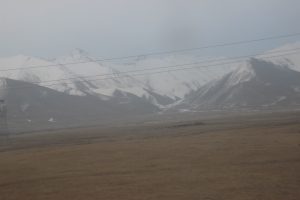We awoke just before 8:00 a.m. to see mountains still to our left and still of the old, red sandstone. The railway line, although improved for high speed running was still faced with the same geographical challenges of the old route, namely the Gansu Corridor, which narrows as the mountains come together some 300km south of Mongolia. This is a very challenging part of the world for railway construction as there are a mixture of rocks, narrowing valleys and increased altitude. The view from the window clearly showed us a most inhospitable and the remotest part of our journey. From 8:10 a.m. we travelled for at least 9 1/2 hours, initially climbing and later descending, but always passing through tunnels ranging from 400m in length to 4 or 5 km. At some stages no sooner had our carriage left a tunnel than we were in another one. Progress was slow for the 9 1/2 hours as some of the curves were tight and the flanges of the wheels scraped the rails. When we crossed the watershed we followed the River Wei, which is a tributary of the Yellow River, which we actually crossed later in the day. The mountains here are about 3 – 4000m in height and rise suddenly from the valley floor, so looking out of the window one can see how these peaks dominate the landscape. The River Wei has multiple sources on these mountains which quickly join to form the larger river and in doing so means that the river in the mountains exhibits features that one normally sees on lower terrain closer to the river’s mouth. The River Wei in cutting through the mountain range meanders considerably so out railway line in both following the river and maintaining a high speed route is constantly cutting off the corner and leaving the river valley by tunnelling through a spur of the mountain to regain the River Wei’s valley. In the valley farmers appear to have every last metre of land available. There are terraced fields, irrigation channels and collective farms all above the river on what seemed to be very small patches of land.
The old, red sandstone is also joined by the loess of this region. These are river and glacial sands which are easily eroded. It is this erosion that gives the Yellow River its name and is known as the world’s muddiest.
By 14:57 we had reached Tianshui, a distance of about 300km from Xi’an and entered historic Shaanxi Province. We still clung to the River Wei and continued through even more tunnels and it was not until 17:40 p.m. at Baoji that we left the tunnels behind and started to speed down the wider valley towards Xi’an, arriving at 19:21 p.m. The approach to Xi’an was spectacular with brightly illuminated buildings and single-stay suspension bridge across the river, and the tastefully decorated city walls and gateways with neon crenallations. A short taxi ride took us to the hotel by the Bell Tower, which was now illuminated and made a fabulous sight when viewed through the glass walls of the hotel lobby. We had soon checked in and eating a spicy rack of lamb with steamed rice at the restaurant next door!










